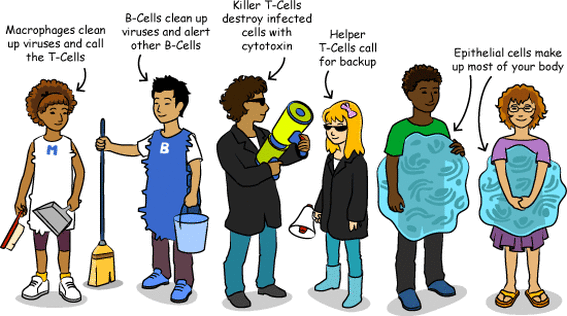Viral Defence System
 Representation of key players with their specific functions in the immune system.
Representation of key players with their specific functions in the immune system.
Human bodies have numerous means of defending against viral attacks, referred to as our immune system. Defences against viruses are broken down into two general categories of immunity - innate and adaptive immunity.
Innate immunity is based on what we are all born with, including physical barriers such as skin, hair, earwax, saliva, stomach acid, cilia, mucus, tears, oil, etc., which help prevent viruses from entering our bodies as the first line of defence. When viruses make it past these barriers, the secondary line of defence (also innate) is triggered: white blood cell phagocytes. Phagocytes are cells that indiscriminately "eat" foreign particles and pathogens, by deactivating and then engulfing and destroying them through the process of phagocytosis. Macrophages are one such type of phagocyte.
Adaptive immunity includes more advanced biological defence mechanisms that develop as we grow, acquiring memory recognition of pathogens. It is considered the third line of defence when innate immunity cannot quell a viral attack, and it is highly specialized and can protect against almost any type of invader. This defence depends on lymphocytes that are white blood cells categorized as either B-cells or T-cells. B-cells produce protective proteins called antibodies, which engage the protein covering of viruses, tag them for destruction and prevent viruses from infecting other cells. T-cells attack the pathogen directly but usually require other cells to help them recognize the invader so they can bind to it. Once they have bound to the foreign antigen, T-cells are signalled to activate, which causes them to enlarge, divide, and release a chemical called cytotoxin that destroys the pathogen. Both B-cells and T-cells can retain memory of the specific pathogen in order to respond with greater strength should it invade the body again.
Anther form of defence against viruses occurs with the production of interferons by virus-infected cells. Inteferons protect non-infected cells from viruses by coating their proteins in the cell membrane, causing them to be unrecognized by the virus. This helps to slow the viral infection process to give more time for white blood cells and antibodies to do their job.
Innate immunity is based on what we are all born with, including physical barriers such as skin, hair, earwax, saliva, stomach acid, cilia, mucus, tears, oil, etc., which help prevent viruses from entering our bodies as the first line of defence. When viruses make it past these barriers, the secondary line of defence (also innate) is triggered: white blood cell phagocytes. Phagocytes are cells that indiscriminately "eat" foreign particles and pathogens, by deactivating and then engulfing and destroying them through the process of phagocytosis. Macrophages are one such type of phagocyte.
Adaptive immunity includes more advanced biological defence mechanisms that develop as we grow, acquiring memory recognition of pathogens. It is considered the third line of defence when innate immunity cannot quell a viral attack, and it is highly specialized and can protect against almost any type of invader. This defence depends on lymphocytes that are white blood cells categorized as either B-cells or T-cells. B-cells produce protective proteins called antibodies, which engage the protein covering of viruses, tag them for destruction and prevent viruses from infecting other cells. T-cells attack the pathogen directly but usually require other cells to help them recognize the invader so they can bind to it. Once they have bound to the foreign antigen, T-cells are signalled to activate, which causes them to enlarge, divide, and release a chemical called cytotoxin that destroys the pathogen. Both B-cells and T-cells can retain memory of the specific pathogen in order to respond with greater strength should it invade the body again.
Anther form of defence against viruses occurs with the production of interferons by virus-infected cells. Inteferons protect non-infected cells from viruses by coating their proteins in the cell membrane, causing them to be unrecognized by the virus. This helps to slow the viral infection process to give more time for white blood cells and antibodies to do their job.
The comic book illustration below demonstrates in a simplified way the body's defence system against a viral attack, showing the specific functions each of the key cells have in the immune system:
Your browser does not support viewing this document. Click here to download the document.
This concludes our exploration of viruses, and we will turn our attention next to the world of bacteria!
